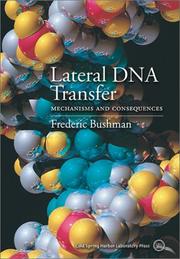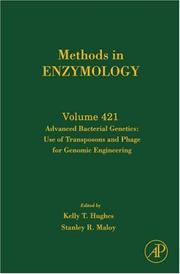| Listing 1 - 10 of 55 | << page >> |
Sort by
|
Book
ISBN: 354059342X 3642797970 3642797954 Year: 1996 Volume: 204 Publisher: Berlin : Springer,
Abstract | Keywords | Export | Availability | Bookmark
 Loading...
Loading...Choose an application
- Reference Manager
- EndNote
- RefWorks (Direct export to RefWorks)
Tn elements --- Transposable elements --- Transposonen --- Transposons --- DNA Transposable Elements. --- Transposons. --- Moleculaire biologie.
Book
Year: 2016 Publisher: Frontiers Media SA
Abstract | Keywords | Export | Availability | Bookmark
 Loading...
Loading...Choose an application
- Reference Manager
- EndNote
- RefWorks (Direct export to RefWorks)
Repetitive structures in biological sequences are emerging as an active focus of research and the unifying concept of "repeatome" (the ensemble of knowledge associated with repeating structures in genomic/proteomic sequences) has been recently proposed in order to highlight several converging trends. One main trend is the ongoing discovery that genomic repetitions are linked to many biological significant events and functions. Diseases (e.g. Huntington's disease) have been causally linked with abnormal expansion of certain repeating sequences in the human genome. Deletions or multiple copy duplications of genes (Copy Number Variations) are important in the aetiology of cancer, Alzheimer, and Parkinson diseases. A second converging trend has been the emergence of many different models and algorithms for detecting non-obvious repeating patterns in strings with applications to in genomic data. Borrowing methodologies from combinatorial pattern, matching, string algorithms, data structures, data mining and machine learning these new approaches break the limitations of the current approaches and offer a new way to design better trans-disciplinary research. The articles collected in this book provides a glance into the rich emerging area of repeatome research, addressing some of its pressing challenges. We believe that these contributions are valuable resources for repeatome research and will stimulate further research from bioinformatic, statistical, and biological points of view.
Algorithms --- Repetitive structures --- next generation sequencing --- tandem repeats --- transposable elements
Book
Year: 2016 Publisher: Frontiers Media SA
Abstract | Keywords | Export | Availability | Bookmark
 Loading...
Loading...Choose an application
- Reference Manager
- EndNote
- RefWorks (Direct export to RefWorks)
Repetitive structures in biological sequences are emerging as an active focus of research and the unifying concept of "repeatome" (the ensemble of knowledge associated with repeating structures in genomic/proteomic sequences) has been recently proposed in order to highlight several converging trends. One main trend is the ongoing discovery that genomic repetitions are linked to many biological significant events and functions. Diseases (e.g. Huntington's disease) have been causally linked with abnormal expansion of certain repeating sequences in the human genome. Deletions or multiple copy duplications of genes (Copy Number Variations) are important in the aetiology of cancer, Alzheimer, and Parkinson diseases. A second converging trend has been the emergence of many different models and algorithms for detecting non-obvious repeating patterns in strings with applications to in genomic data. Borrowing methodologies from combinatorial pattern, matching, string algorithms, data structures, data mining and machine learning these new approaches break the limitations of the current approaches and offer a new way to design better trans-disciplinary research. The articles collected in this book provides a glance into the rich emerging area of repeatome research, addressing some of its pressing challenges. We believe that these contributions are valuable resources for repeatome research and will stimulate further research from bioinformatic, statistical, and biological points of view.
Algorithms --- Repetitive structures --- next generation sequencing --- tandem repeats --- transposable elements
Book
Year: 2016 Publisher: Frontiers Media SA
Abstract | Keywords | Export | Availability | Bookmark
 Loading...
Loading...Choose an application
- Reference Manager
- EndNote
- RefWorks (Direct export to RefWorks)
Repetitive structures in biological sequences are emerging as an active focus of research and the unifying concept of "repeatome" (the ensemble of knowledge associated with repeating structures in genomic/proteomic sequences) has been recently proposed in order to highlight several converging trends. One main trend is the ongoing discovery that genomic repetitions are linked to many biological significant events and functions. Diseases (e.g. Huntington's disease) have been causally linked with abnormal expansion of certain repeating sequences in the human genome. Deletions or multiple copy duplications of genes (Copy Number Variations) are important in the aetiology of cancer, Alzheimer, and Parkinson diseases. A second converging trend has been the emergence of many different models and algorithms for detecting non-obvious repeating patterns in strings with applications to in genomic data. Borrowing methodologies from combinatorial pattern, matching, string algorithms, data structures, data mining and machine learning these new approaches break the limitations of the current approaches and offer a new way to design better trans-disciplinary research. The articles collected in this book provides a glance into the rich emerging area of repeatome research, addressing some of its pressing challenges. We believe that these contributions are valuable resources for repeatome research and will stimulate further research from bioinformatic, statistical, and biological points of view.
Algorithms --- Repetitive structures --- next generation sequencing --- tandem repeats --- transposable elements --- Algorithms --- Repetitive structures --- next generation sequencing --- tandem repeats --- transposable elements
Dissertation
Year: 1987 Publisher: Dordrecht ICG printing
Abstract | Keywords | Export | Availability | Bookmark
 Loading...
Loading...Choose an application
- Reference Manager
- EndNote
- RefWorks (Direct export to RefWorks)
DNA Transposable Elements --- DNA, Viral --- Bacteriophages --- Bacteriophage mu --- genetics --- genetics --- genetics
Book
ISBN: 0716711117 9780716711117 Year: 1979 Publisher: Oxford Freeman
Abstract | Keywords | Export | Availability | Bookmark
 Loading...
Loading...Choose an application
- Reference Manager
- EndNote
- RefWorks (Direct export to RefWorks)
Plasmids --- PLASMIDS --- Plasmids. --- Paragenes --- Cytoplasmic inheritance --- Genetic vectors --- Mobile genetic elements --- Extrachromosomal DNA --- Episome --- Plasmid --- Episomes --- DNA Transposable Elements --- Virophages

ISBN: 0521354641 Year: 1988 Volume: vol 43 Publisher: Cambridge Cambridge University press
Abstract | Keywords | Export | Availability | Bookmark
 Loading...
Loading...Choose an application
- Reference Manager
- EndNote
- RefWorks (Direct export to RefWorks)
DNA Transposable Elements. --- Elements, Insertion Sequence --- Sequence Elements, Insertion --- DNA Insertion Elements --- DNA Transposons --- IS Elements --- Insertion Sequence Elements --- Tn Elements --- Transposable Elements --- DNA Insertion Element --- DNA Transposable Element --- DNA Transposon --- Element, DNA Insertion --- Element, DNA Transposable --- Element, IS --- Element, Insertion Sequence --- Element, Tn --- Element, Transposable --- Elements, DNA Insertion --- Elements, DNA Transposable --- Elements, IS --- Elements, Tn --- Elements, Transposable --- IS Element --- Insertion Element, DNA --- Insertion Elements, DNA --- Insertion Sequence Element --- Sequence Element, Insertion --- Tn Element --- Transposable Element --- Transposable Element, DNA --- Transposable Elements, DNA --- Transposon, DNA --- Transposons, DNA --- Mutagenesis, Insertional --- Retroelements --- DNA Transposable Elements --- Conferences - Meetings --- Microbial genetics --- Congresses --- Translocation (Genetics)

ISBN: 0879696036 0879696214 9780879696030 Year: 2002 Publisher: Cold Spring Harbor Cold Spring Harbor Laboratory Press
Abstract | Keywords | Export | Availability | Bookmark
 Loading...
Loading...Choose an application
- Reference Manager
- EndNote
- RefWorks (Direct export to RefWorks)
Transfection --- Transposons --- Mobile genetic elements --- Interspersed Repetitive Sequences --- Eléments génétiques mobiles --- Séquences répétées dispersées --- Transfert de gène --- Gene transfer --- Mobile genetic elements. --- Transposons. --- Transfection. --- Genetic transformation --- Viral genetics --- Tn elements --- Transposable elements --- Genetic elements, Mobile --- Genetic mobile elements --- Mobile DNA --- Mobile DNA sequences --- Mobile elements, Genetic --- Eléments génétiques mobiles --- Séquences répétées dispersées --- Nucleic acids --- DNA --- Molecular genetics --- ADN --- DNA Transposable Elements --- DNA. --- GENOMES --- GENE TRANSFER --- MONOGRAPHS --- EVOLUTION
Book
ISBN: 3642242529 3642020046 9786612655074 1282655078 3642020054 Year: 2009 Publisher: Dordrecht ; New York : Springer,
Abstract | Keywords | Export | Availability | Bookmark
 Loading...
Loading...Choose an application
- Reference Manager
- EndNote
- RefWorks (Direct export to RefWorks)
There are only few major key functions that lie beneath the fundamental architecture of metabolism and life. These are multiplication, variation and heredity. Only if these factors interact synergistically can Darwinian selection power the evolution of biodiversity. Transposable elements have always played a major role in this process. The genomes of all organisms consist of chromosomes that are built up of double-stranded nucleic acid chains on whose stability and integrity the existence of cells depend. While DNA repair warrants the chemical integrity of DNA and protects it from metabolic and environmental mutagens, meiotic recombination and transposable element activity appear to counteract the molecular guardians of genome stability. Transposable elements and their kind often make up the bulk of genomic DNA, often approaching 50% of the genome. By contrast, the classic genes represent as little as 1.8% of genomic DNA, in case of the human genome. This volume gives an overview on mobile DNA and how such contradiction to the obligatory stability of genomes can be understood. Obviously, an understanding can only be achieved by cutting deeply into the evolutionary history of life along with the evolution of transposable elements and dynamic genomes. This book therefore also celebrates Charles Darwin’s 200th birthday. The reader is challenged to view the role of movable DNA along historical roots from the levels of cells to populations to biological species integrating the accompanying molecular evolution of host, cell and genome interaction. One will witness even the reactivation of a long since dead, fossil transposable element and the infection of germline cells by the first established, mobile and endogenous insect retrovirus.
Genomes --Stability. --- Genomes. --- Molecular dynamics. --- Transposons. --- Transposons --- Genomes --- Molecular dynamics --- DNA Transposable Elements --- Interspersed Repetitive Sequences --- DNA --- Genome Components --- Repetitive Sequences, Nucleic Acid --- Nucleic Acids --- Base Sequence --- Nucleic Acids, Nucleotides, and Nucleosides --- Genome --- Genetic Structures --- Chemicals and Drugs --- Molecular Structure --- Biochemical Phenomena --- Genetic Phenomena --- Phenomena and Processes --- Chemical Phenomena --- Biochemistry --- Genetics --- Biology - General --- Biology --- Chemistry --- Physical Sciences & Mathematics --- Health & Biological Sciences --- Stability --- Molecular genetics. --- Tn elements --- Transposable elements --- Life sciences. --- Human genetics. --- Biochemistry. --- Cell biology. --- Life Sciences. --- Biochemistry, general. --- Cell Biology. --- Human Genetics. --- Mobile genetic elements --- Molecular biology --- Cytology. --- Heredity, Human --- Human biology --- Physical anthropology --- Cell biology --- Cellular biology --- Cells --- Cytologists --- Biological chemistry --- Chemical composition of organisms --- Organisms --- Physiological chemistry --- Medical sciences --- Composition

ISBN: 9780123737496 0123737494 9786611003647 1281003646 0080475108 Year: 2007 Volume: 421 Publisher: Amsterdam Academic press
Abstract | Keywords | Export | Availability | Bookmark
 Loading...
Loading...Choose an application
- Reference Manager
- EndNote
- RefWorks (Direct export to RefWorks)
The critically acclaimed laboratory standard for more than fifty years, Methods in Enzymology is one of the most highly respected publications in the field of biochemistry. Since 1955, each volume has been eagerly awaited, frequently consulted, and praised by researchers and reviewers alike. Now with over 400 volumes (all of them still in print), the series contains much material still relevant today-truly an essential publication for researchers in all fields of life sciences. This new volume presents methods related to the use of bacterial genetics for genomic engineering. The book in
Genetic engineering. --- Bacterial genetics. --- Bacteriophages. --- Transposons. --- Organisms --- DNA --- Nucleic Acids --- Nucleic Acids, Nucleotides, and Nucleosides --- Chemicals and Drugs --- DNA, Bacterial --- Bacteria --- Biology --- Human Anatomy & Physiology --- Health & Biological Sciences --- Animal Biochemistry --- Genetics --- 577.15 --- Enzymes. Catalysts of biological reactions. Enzymology --- 577.15 Enzymes. Catalysts of biological reactions. Enzymology --- Bacteriophage --- Phages --- Tn elements --- Transposable elements --- Monograph --- Viruses --- Lysogeny --- Transduction --- Mobile genetic elements --- Bacteriology --- Microbial genetics
| Listing 1 - 10 of 55 | << page >> |
Sort by
|

 Search
Search Feedback
Feedback About UniCat
About UniCat  Help
Help News
News